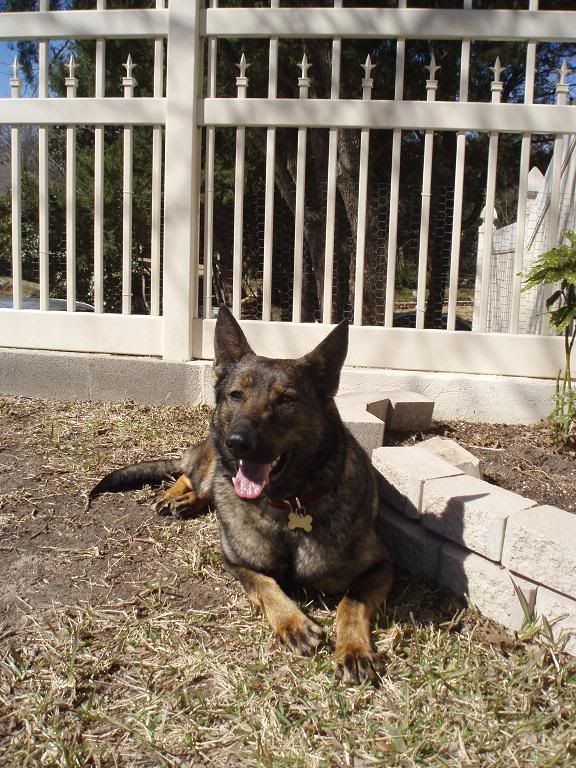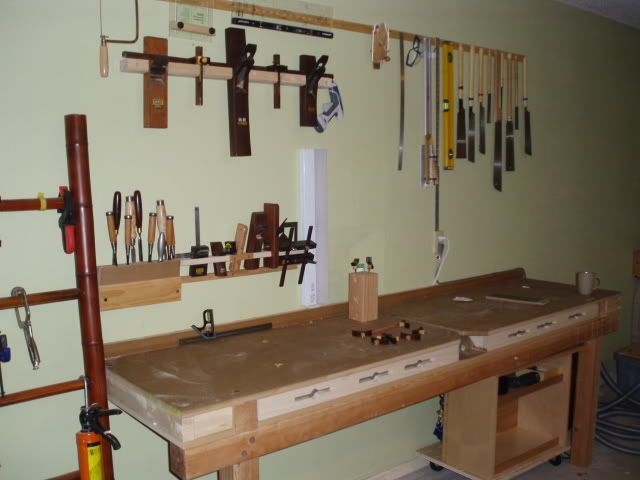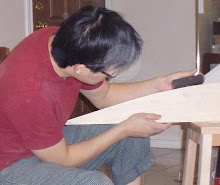
This year went by too quickly. I managed to move to an actual house with a garage and then added two German Shepherd Dogs to the family. This is severely affected my woodworking time. But many woodworkers would agree that the fun of this hobby is problem solving. I took the time constraint into consideration when I built a workbench in the new garage/shop. All the tools needed were exposed and within easy reach. You see, my solution was to build things quicker. This meant getting to the tools faster as well as a change in design and philosophy.
So the idea is to get rid of SOME of the old world craftsmanship hype and adopt modern day techniques that has proven itself in the industry over the last 50 years. I can say this because I can hand cut a dovetail or chop a mortise with a chisel like they did 400 years ago. I just don't have time to do that that to anymore. The dogs need their walks and my wife needs a desk for her computer. I want to make more than two projects a year. There's too many ideas in my head that need fruition. Somethings has got to give and it's not the wife nor the dogs.
Screws and nails to the rescue!
More importantly that's pocket screws and wooden dowels acting as nails. The result is a Computer desk that took me less than six hours to conceptualize and built. Not much happened in the area of design, as I had to build a desk that is 23" deep by 45" wide, the height is a standard 29" high. The table got four legs and a plywood top. That's as basic as it gets.
So here's my shortcut. All four legs are tapered by cutting wedges off the square stock with the circular saw with a guild rail. I eyeball much of operations, meaning none of the legs are identical to each other. They are all different sizes. I saved layout time, and they are far apart from one another that no one can tell the difference anyways, anyone who is bothered by this shouldn't be on his hands and knees in MY house measuring the leg of a computer desk!
Aprons are attached to legs with dowels and pocket screws. This let me assemble as I cut, making changes and noticing problem areas as I go along. Saved a lot of time from over analyzing and designing. I can quickly take things apart to tweak any parts, luckily I have enough experience that this project came together with very little resistance from the forces that be.
Not a single miter joints anywhere. That's right, even the edge band is rough cut, glued and pinned to the plywood, and then next piece is butted to it. This way, I can trim everything to length after the glue up with the Japanese hand saw. Then everything is planed smooth while on top with radii plane and block plane. It saves measure time and I didn't need to take out the miter saw.
The plywood top was previously finished as it was rescued from a closet I had dismantled at the old house. This means it's dimensionally stable, so a few pocket screws from the apron and it's secured.
Sure there's no hunched tennon with locking pins on this table, but I built this table in 1/3 the time and it looks just as good and is just as strong. I'm beginning to look forward to next year because my wife will be enjoying some furniture instead of waiting for me to complicate an otherwise simple task of joining two pieces of wood. Here's to progressing as a woodworker.
 This year went by too quickly. I managed to move to an actual house with a garage and then added two German Shepherd Dogs to the family. This is severely affected my woodworking time. But many woodworkers would agree that the fun of this hobby is problem solving. I took the time constraint into consideration when I built a workbench in the new garage/shop. All the tools needed were exposed and within easy reach. You see, my solution was to build things quicker. This meant getting to the tools faster as well as a change in design and philosophy.
This year went by too quickly. I managed to move to an actual house with a garage and then added two German Shepherd Dogs to the family. This is severely affected my woodworking time. But many woodworkers would agree that the fun of this hobby is problem solving. I took the time constraint into consideration when I built a workbench in the new garage/shop. All the tools needed were exposed and within easy reach. You see, my solution was to build things quicker. This meant getting to the tools faster as well as a change in design and philosophy.


















